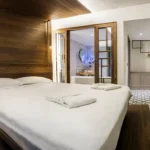Transforming small spaces: functional interior design tips, kitchen cooking experience advice, house range hoods
Transforming Small Spaces: The Art of Functional Interior Design
27 May 2023
Small spaces can be both challenging and exciting when it comes to interior design. With limited square footage, it’s tricky to make the most of the available space while still creating stylish and functional living areas. You also have to balance the budget: it might seem like a smaller space requires less stuff, and should therefore have a lower budget required, but this is not always the case! In this article, we’ll showcase creative tips and techniques that will help you transform your small spaces into inviting and efficient environments.
1. Incorporate Efficient Kitchen Appliances
For small spaces like studios or small apartments, an efficient kitchen design is essential. Selecting space-saving appliances, such as slimline dishwashers and compact ovens, can greatly improve the functionality of your kitchen. Furthermore, investing in attractive and functional range hoods can contribute to a better airflow in your kitchen, making your cooking experience more enjoyable while maximizing your space, and making the room seem less stuffy, lighter and more open.
2. Maximize Vertical Space
One simple way to create more space in your small room is to use the vertical space that is often overlooked. Adding shelves and storage units high up on the walls can free up the limited floor space and enable you to display decorative items, books, or household items that would otherwise contribute to clutter.
3. Multi-purpose Furniture
Choosing the right furniture for a small space is crucial. Multi-functional furniture pieces not only save space but also make your home look more cohesive and put together. Some examples of multi-purpose furniture include:
- Sofa beds
- Storage ottomans
- Extendable dining tables
- Fold-out desks
4. Creative Storage Solutions
In a small living area, it’s essential to keep everything neat and organized. Creative storage solutions can help minimize clutter, making your space feel larger and more comfortable. Consider the following:
- Under-bed storage
- Wall-mounted coat racks
- Built-in shelves and cabinets
- Using drawer organizers
5. Use Mirrors Wisely
Strategically placing mirrors can create the illusion of depth and space in a small room. Place a large mirror opposite a window to reflect natural light, brightening up the space while making it appear larger. Smaller mirrors can also be used as decorative elements to add visual interest and depth to your walls.
6. Selecting the Right Color Palette
The colors you choose for your small space play a significant role in making the room feel bigger or smaller. Light, warm colors can create a sense of openness and space, while darker, cooler colors may make the room feel more closed-in. Consider using a monochromatic color scheme with different shades of the same color for a cohesive, expansive look.
7. Opt for Vertical Lines
Incorporating vertical lines into your small space design can give the impression of height and more room. This can be done through various techniques, such as installing tall bookshelves, using vertical patterns on walls or textiles, or even hanging tall artwork that draws the eye upward.
8. Let There Be Light
Proper lighting not only makes a space attractive but also has the power to make it feel more spacious. Ensure there is adequate natural light coming in through the windows, and add floor or table lamps in darker areas to create a more inviting and open atmosphere. Layering your lights by using a combination of task, ambient, and accent lighting can help establish a comfortable, welcoming environment.
9. Optimize Traffic Flow
The layout of furniture and objects in a small space greatly affects the perceived size of the room. Arrange your furniture in a way that allows for smooth traffic flow and emphasizes open pathways. By minimizing obstructions and creating a sense of movement, you can make your small space feel more spacious and harmonious.
10. Choose Appropriate Scale
When selecting furniture pieces for your small space, consider the scale and size of each item. Oversized furniture can make a room feel cramped, while smaller, appropriately sized pieces can create a more open and balanced appearance. Opt for furnishings that fit comfortably within the scale of your space, and arrange them in a way that maintains visual balance.
11. Emphasize Openness
Creating a sense of openness can greatly impact the perception of a small room. Use open shelves, glass tables, and other visually lightweight furniture to prevent the room from feeling closed-in. Maintain clear sightlines from one corner of the room to another, and avoid blocking windows and natural light sources. An open and airy layout will allow your small space to feel larger and more welcoming. As described above, mirrors can also help with increasing the openness of a room or space.
Transforming small spaces: functional interior design Summary
Although small living spaces can be challenging, there is no shortage of possibilities when it comes to functional and beautiful interior design. By implementing these tips and techniques, you can transform even the smallest areas into stunning, efficient, and comfortable living spaces. Embrace the challenge and let your creativity shine!
Comments on this guide to Transforming small spaces: functional interior design article are welcome.
Architecture
Rowanbank Gardens Edinburgh Housing
West Town Edinburgh Property Vision
Interior Design
ideas-for-a-modern-interior-design
Factors that influence interior painting cost
Historic Edinburgh homes interior design
Integrating wardrobes into interior design
Comments / photos for the Transforming small spaces: functional interior design advice guide page welcome





